What is an audio interface?
Let’s start from the very beginning because before learning how to use an audio interface you have to know what they are.
Every time I start a guide for new users I get all this excitement; it takes me back to my first steps. I was a young guitar player and all my aspirations in life were to have a punk band and play everywhere I could while distributing fanzines and jumping into mosh pits.
Life is curious, so here I am, 20 years later with a home studio, a family, and not enough hair to pull off the Mohawk style anymore.
The good thing is that in those 20 years I learned a lot.
I started like many of us do with a four-track Tascam cassette recorder and a mixer.
While my bandmates were concerned about looking good and jumping high while striking the chord I opened up my musical horizons and started getting into recording. All I did back then was analog to analog, but times have changed a lot.
Many people are getting started with the incredible Scarlett 2i2 Audio Interface pictured below. (More on this later)
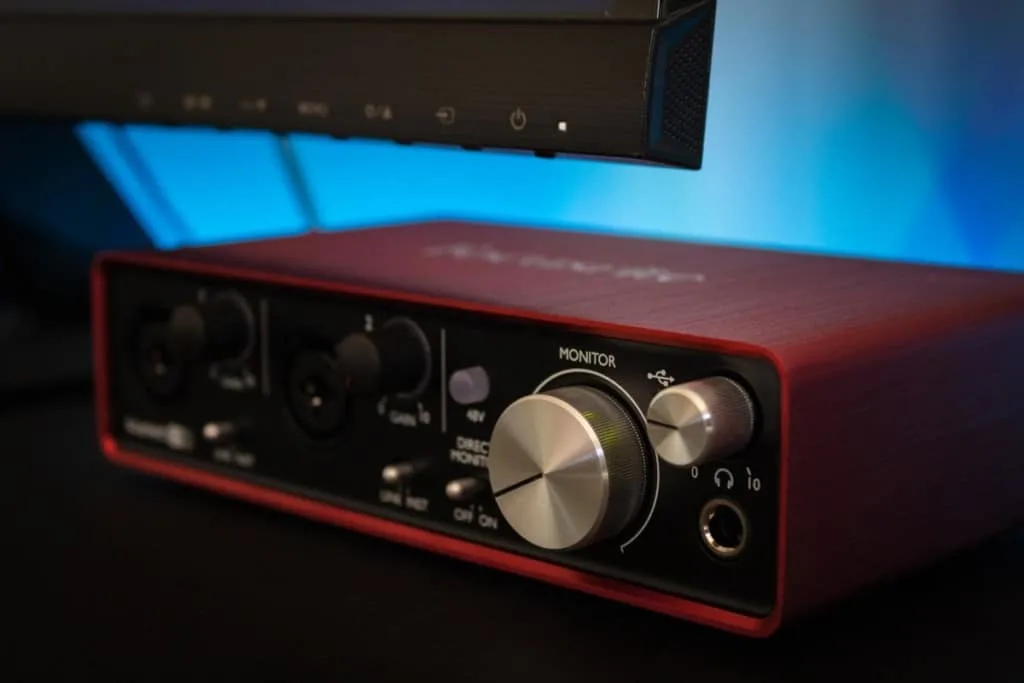
An Audio Interface Is, Basically, A Translator.
Analog waveforms are rich and continuous but can’t be read by a computer, they speak two different languages. So, an audio interface is a fancy, well-accessorized DAC (Digital Audio Converter).
What an interface does is emulate the curves of an audio waveform with zeros and ones. This means that the larger amount of zeros and ones, the closer it will get to the original.
If you want to make a graphic analogy, we can think of pixels. The larger the number of pixels available, the closer it will get to the real deal, which is, of course, the human eye. An image that is low quality (an emulation of reality made with few pixels) can’t be stretched too big or pixels will become bigger and the puppet will show the threads.
Analogy number two: I don’t know how old are you but I grew up playing NES games like Super Mario Bros and those were 8-bit games. Then SNES came along with 16-bits. A museum piece already is Play Station 1 with ground-breaking 32-bits.
If you follow that line you’ll realize that games became more realistic, video game artists were able to recreate reality closer and closer. Nowadays, playing an RPG game in a computer is as close as being in the crossfire action as it gets without getting hurt.
Finally, to finish this illustrative introduction, let’s talk about music.
I used to download it using Napster and those types of streaming services. I remember hearing pirate and live versions of early Limp Bizkit songs and flipping out. Those were in 96Kbps and sounded really bad when you cranked them up.
Nowadays, streaming services use nothing below 320kbps. This means that there’s 320kb of information in each second and hence, the zeros-and-ones curve is closer to the original analog waveform.
- An audio interface works both ways; it turns analog into digital and sends it to the computer and digital into analog sending the info from the computer back to the speakers and headphones. As we’ll see later on, much of your investment is going to be heard in the final audio quality.
Here’s a really clear video that explains what an Audio Interface Is and the main features.
The Importance Of AD/DA Converters
AD/DA converters are the heart and soul of your audio interface. They have many more bells and whistles to offer you, but their main purpose is to convert data. Depending on the quality of the data conversion, the quality of the audio your computer will receive and your final mix will have.
To give you an example let’s say you own a five thousand dollars Gibson R7 and plug it into a three thousand dollars vintage Marshall JTM45 that goes to a thousand dollars cabinet and is captured by three microphones adding another thousand dollars.
You have a sound worth $10,000. It sounds beyond amazing in real life. What happens when you convert it to digital is that the A/D converter will try to emulate that tube richness, overtone harmonics, Honduras mahogany, hand-picked rosewood, and hand-wound pickups with zeros and ones.
The better the quality of the converter, the closer it will be to the real deal.
Investing $10,000 into your rig and sounding like a $500 practice amp is not ideal. The data converters AD/DA are the working-class heroes, the hidden stars of modern music. They are basically the reason why you need a good audio interface.
- Another great Audio Interface to get started with is the Presonus AudioBox 96. Check it out here.
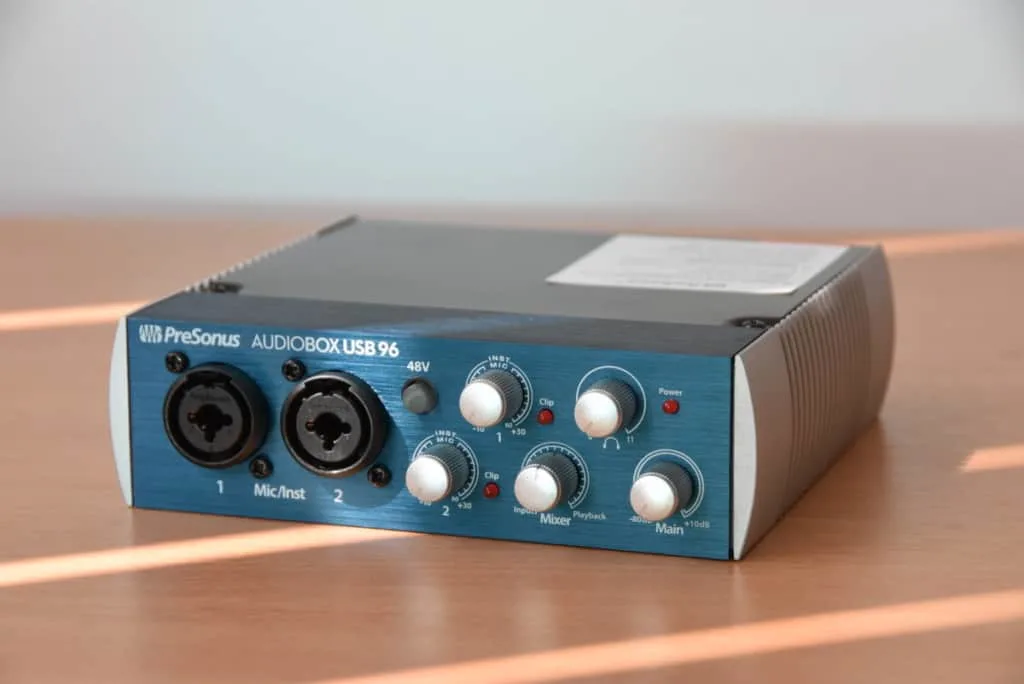
Who Benefits With An Audio interface?
By saying “you need an audio interface” I might be going a little too far. I apologize, but let’s address this with no delays; who can benefit from an audio interface?
· Songwriters – This is one of the possible case scenarios that I think benefited largely from modern music creation tools. An audio interface with one microphone and one line input is perhaps, all that a singer-songwriter needs today. You can record the tracks at home doing as many takes as you want and with the help of VST instruments, you can even add other virtual band members like basses, drums, keyboards, and more. Building songs has never been so easy, believe me.
· Bands – Can an audio interface be used in a band situation? If you don’t have one recording every rehearsal to a laptop then you are missing out on an amazing tool. Being able to go back to every minute of every rehearsal can be crucial to make the best music you humanly can. For this endeavor, you should be looking at something with more inputs to accommodate more mics for the different instruments.
· DJs And Beat Makers – If you are a DJ trying to create music with your computer, you are probably using entirely digital audio, without any instruments other than, perhaps, vocals. Well, in this case, scenario you can benefit hugely from the quality of the D/A converter to send the digital audio signal to the analog speakers or headphones. An audio interface works both ways; as an input and as an output converter.
The Anatomy Of An Audio Interface
Ok, now that we have been through what an audio interface does, it is time to check what the components you’ll expect to find on them are.
Before you get anxious, a lot of how to use an audio interface has to do with learning how to manipulate a DAW and a computer. In this guide for new users we are not going to get deep into that but focus on the hardware.
The more information about the hardware you have, the better, more informed decision you can make when it’s time to purchase.
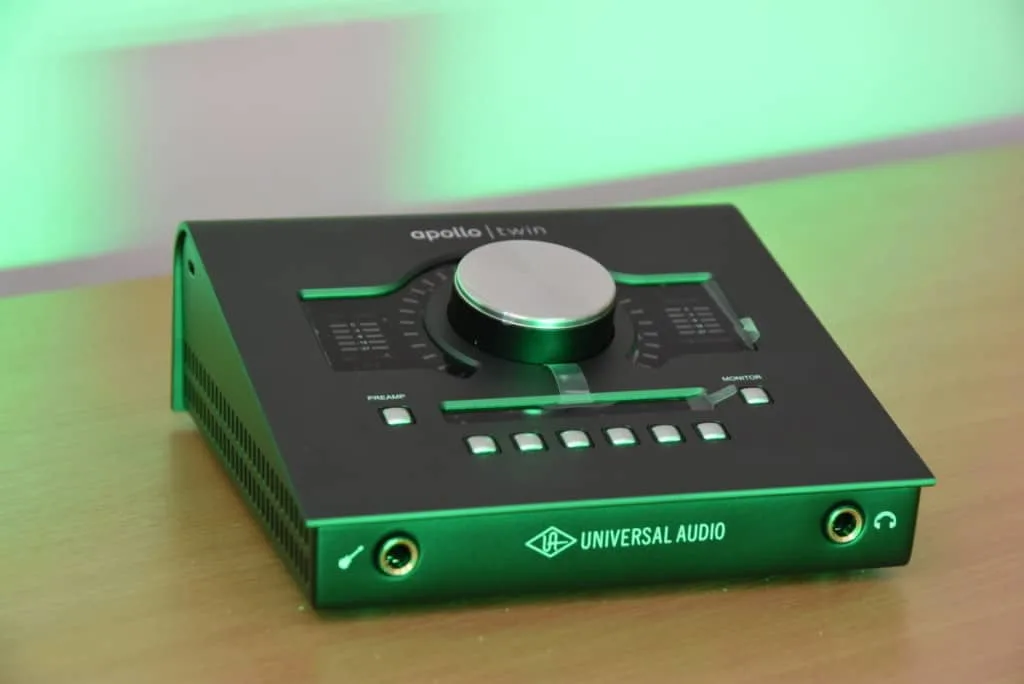
Ins and Outs Of An Audio Interface
First of all, let’s take a look at what the options are when it comes to inputs and outputs. Having in mind the case scenarios above, you should definitely choose the one with the right amount of ins and outs for your project. XLR inputs
These are the inputs that usually have a preamp (more on this later) and can give phantom power (more on this later too).
XLR inputs are for plugging in microphones with balanced, lossless cables. Some of the most common models for entry-level prices will offer you one XLR and one instrument input.
Bear in mind that if that is the case, the only way for a singer-songwriter to play and sing is to go into it with a single microphone and plugging your guitar into a line. Hi-Z or High impedance inputs
If your audio interface has a Hi-Z input it means that you can plug your electric guitar or acoustic guitar into it and keep the high frequencies.
It’s like having a DI box between your guitar and the computer. It will amplify weak signals so they can be used in dedicated software. For example, if you use the Amplitube or any of those programs with your computer, you can plug straight into the Hi-Z and the guitar will sound great.
The input has to be labeled Hi-Z and is a 1/4” input. If it is not labeled, check the manual to make sure it is a high impedance input.
Combined Audio Interface Inputs
This is the most modern way to combine TRS and XLR in one socket. You can recognize these immediately since they are just like your XLR inputs with a hole in the middle for a TRS cable.
For a while now, companies have been manufacturing balanced high-quality TRS cables that conduce electrical current perfectly throughout their entire length. In these kinds of jacks, you can plug in either an XLR or a TRS and have access to preamps and phantom power.
Going back to the singer-songwriter scenario, if you want to do a take in which you sing and play acoustic with two microphones and your audio interface has two combined inputs, you can do it perfectly. Regular 1/4” inputs
Your audio interface can also have this kind of input which is non-assisted audio.
This means that it is only an AD/DA converter (usually) with no preamp, phantom power, or Hi-Z capabilities. What can you plug in such an input? Well, it works great for high-volume instruments. For example, if you are as lucky as I am and have a synth or two around like the Korg K1 or a digital piano, you can plug those in.
The difference between those instruments and a guitar is that they have a volume knob that goes through a preamp stage and reaches the audio interface at a higher gain; enough for a DAW to record it properly in most cases.
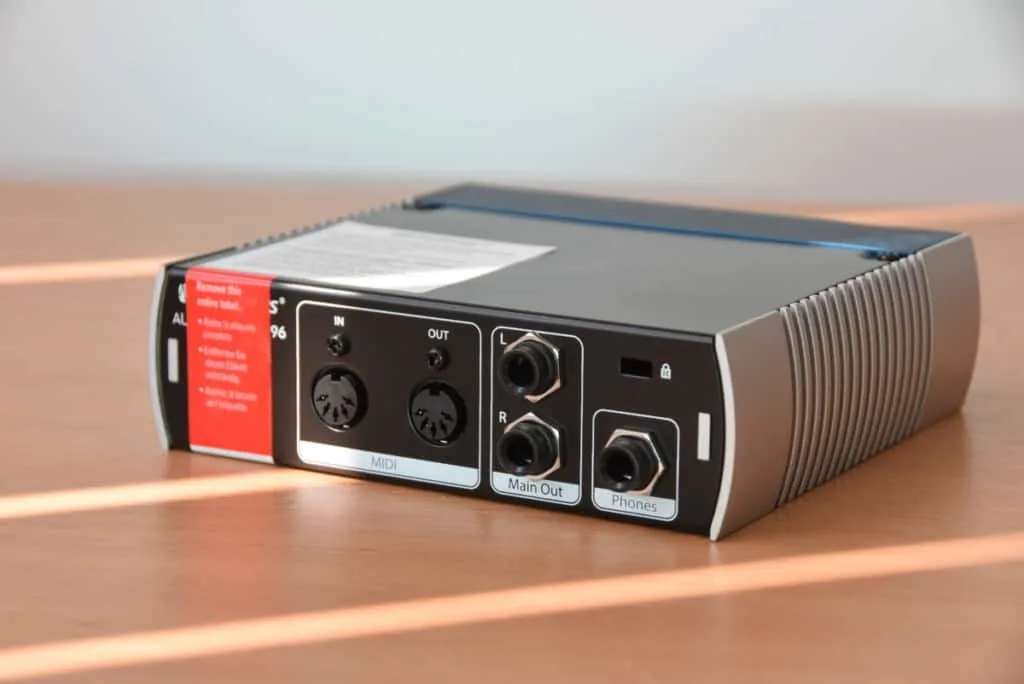
Audio Interface Balanced Outs
Balanced outs are what you use to go to studio monitors.
These are lossless connections that can be in the shape of XLR or TRS. If you have some good studio monitors like KRK Rokits or Mackie MR Series you will very likely have two active powered speakers with one input each to go to.
Your audio interface should have two balanced outputs, one for each.
Non-Balanced Outs
Balanced outs are not something that’s standard for all the audio interfaces out there, some of them also offer unbalanced RCA connections to accommodate multimedia speakers.
For example, if you decide to buy the super famous M-Audio Fast Track, you are going to have only two RCA outs. In the case that you don’t own and don’t plan on buying studio monitors, then with RCA outs, you are more than covered as long as you have a pair of good studio-quality headphones.
Audio Interface Headphones Out Connections
Speaking of headphones, I would say close to 100% of the audio interfaces out there have a headphones output.
This is crucial not only for mixing but also for monitoring. If you are recording vocals with a sensitive condenser microphone you can’t play the music back through speakers or it will go into the audio track. Headphones are a must for every studio.
I have written an article on how to record vocals without an audio interface. You can read it here.
MIDI Connections For Audio Interfaces
Other inputs that your audio interface might have are MIDI inputs and outputs.
These are for MIDI instruments. MIDI is a technology that was completely paramount to the beginnings of electronic music. Back in the day when computers were not so common, powerful, and practical, many of us still made music with no conventional instruments.
For example, the entire Rick Rubin Hip Hop revolution with DEF JAM records was done through MIDI. The advantage of this technology is that most of the MIDI instruments in the world have an internal MIDI clock and this means that you can sync everything to a single instrument, which is usually a drum machine.
Also, it is a great addition to delay pedals so you can sync your delay times with the song click through the MIDI clock.
Should you buy an audio interface with or without MIDI capabilities?
As a beginner, if you don’t have any MIDI instruments to plug into it you won’t need it. Plus, MIDI cables are expensive and very particular. If you are about to make the transition into the digital world and bringing with you lots of MIDI stuff, then it is going to be important; otherwise, I would say don’t worry about it just yet.
Do Audio Interfaces Have Phantom Power?
Most audio interfaces have phantom power capabilities.
This is a must because you are going to want to record with a condenser microphone to get amazing vocals. Condenser microphones do not work without phantom power; they need those 48 volts to generate sound. Make sure the one you buy can offer you phantom power.
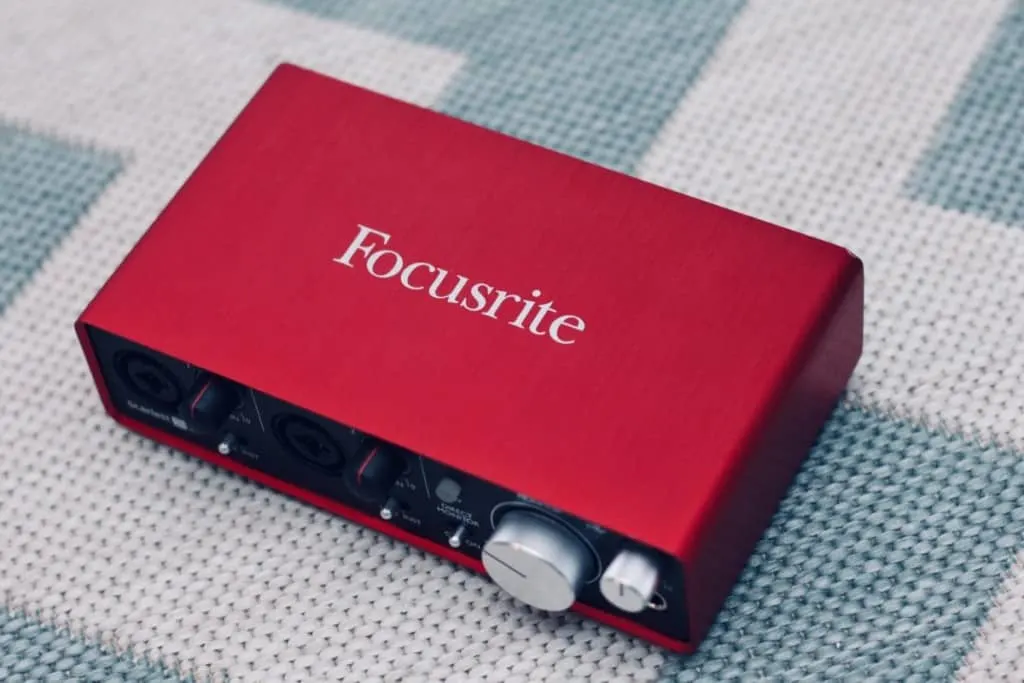
Audio Interface Controls
The controls on most audio interfaces are pretty simple, let’s take a look:
· Master volume – Whenever you plug an audio interface on your computer and configure it, all sound will go through it and hence this master volume will turn into your computer’s master volume knob.
· Input level – Input levels control the gain that each instrument or microphone you plug into your audio interface will reach the computer with. For example, the gain level on a dynamic microphone and a condenser microphone will be drastically different. By adjusting the input level you can avoid clipping.
· Phantom Power Switch – You will very likely have a phantom power switch to turn it on and off depending on the occasion. A very common concern is plugging instruments that don’t need phantom and forgettings it’s on; phantom power doesn’t harm instruments or microphones, don’t worry.
That’s about it for the controls on the interface itself, all the rest of the magic happens in the DAW.
Do Audio Interfaces Have Built-In Preamps?
Preamps are what shape the sound before it reaches the computer. As the name implies, they pre-amplify the signal, and hence what you get is a richer, gainier tone that is usually warmer too.
Also, each preamp is completely different from the next and people invest thousands, hundreds of thousands, or even millions in big mixers because of the preamps they offer.
Usually, in audio interfaces, you have good-quality preamps on each XLR or mixed inputs.
Some people plug their instruments and microphones to external preamps like going to a mixer before the audio interface. This can be a good choice if you don’t like the built-in preamps or are very used to a certain type of sound coming from a piece of gear you have used for a long time.
Finally, there are some external preamps like the ART Tube MP that can help your recordings sound much better. This is to say that preamps are not the most important aspect to base your choice of audio interface on.
Is Latency Still An Issue With Audio Interfaces?
Latency is, at this point, is almost something from the past.
Virtually every audio interface offers no-latency recording and monitoring. Let me tell you that it hasn’t always been this way, in fact, latency used to be an issue. Latency means the amount of time that goes by from the moment you hit the note until you can hear it back.
Zero-latency means that the audio interface does A/D conversion, provides info to the computer, and then D/A so you can hear everything in real-time. I know; it’s amazing!
Here’s a great video that shows how to choose an audio interface for your needs.
Conversion Rate Of A Modern Audio Interface
The conversion rate is how much information the converter is able to process in real-time.
The higher the number, the more quality the final product will have. Just like I said at the beginning of the article, it is how close to the original audio waveform you can get with its digital clone.
The usual is 44.1KHz and if the audio interface you are about to buy can go up to 44.1KHz or 192KHz then you are more than OK. The conversion rate is very important but also pretty much standardized across the board.
Audio Interface Computer Connections
We have seen the connections you can do with your audio interface but we haven’t tackled the most important one yet: the computer connection. There are different ways to connect your audio interface with your computer, let’s take a look.
Audio Interface USB Connections
This is the most common way to connect with your computer and virtually every small audio interface up to two inputs communicates with computers this way.
Most of them like the afore-mentioned Fast Track also get the power to run from this input.
If you are sticking to a low number of channels, you don’t have to worry about this because the amount of data you are generating will not be too much as to generate latency. If you were to use an 8+ channel interface, perhaps you should consider another connection type.
FireWire/Thunderbolt
- FireWire is an almost obsolete computer technology while Thunderbolt is its replacement.
If you are part of a band or a drummer, for example, you might consider investing a little more and getting more channels so you can put more microphones to your instrument and mix it to the minimum detail later on. Bear in mind that you will also need such a port on your computer.
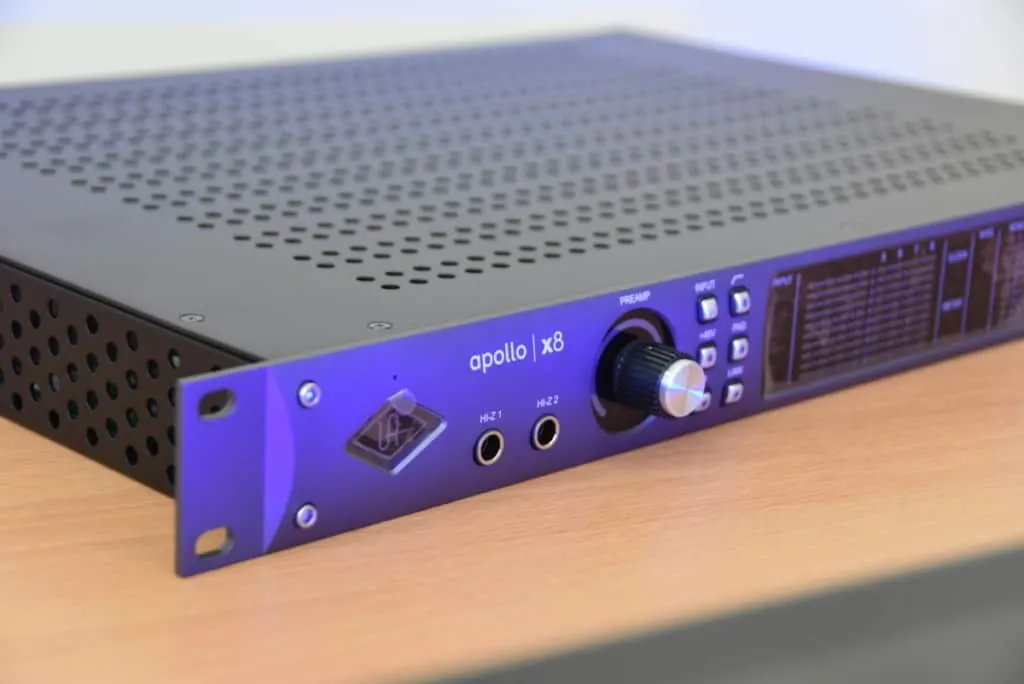
How To Choose The Best Audio Interface For Your Project
The basic concept that you have to understand is that there is not something that’s objectively better than another; the best will always be the one that adapts to your situation the best.
If you buy a very complex, state of the art, interface but are a complete beginner, you won’t be able to enjoy all the things it can do for you. Learning how to use an audio interface requires going through a learning curve even with this amazing guide for new users you are reading. Bear this in mind at all times before making your investment.
The most popular audio interface is the Scarlett 2i2. Take a look at it here.
-
The Scarlett 2i2 is an excellent choice to get started with. The Scarlett has built-in preamps and phantom power included. It also comes with free Ableton software to help you get started.
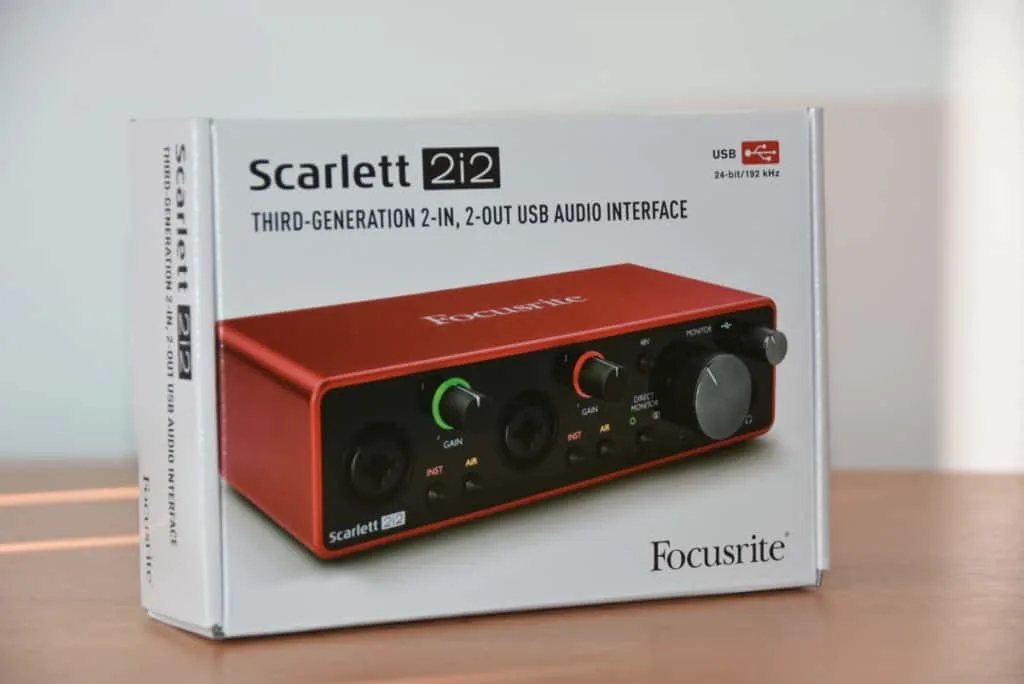
High End Audio Interfaces
At the other end of the scale once you have gained some experience, is the apollo audio interface.
The Apollo Twin Duo is a very popular audio interface and is available with USB and Thunderbolt connections.
Check out the Apollo Twin Audio Interface here.
I have (after many years) just upgraded to the Apollo X8 and I can tell you it is truly amazing, however, you can only truly appreciate the benefits of this type of product by starting with a more basic audio interface.
Check out the Apollo X8 that I chose here.
- One thing I always recommend is to grow your ear before your gear!
Audio Interface Or USB Microphone?
This is a great option for those who only need to record vocals like for example voiceover artists, rappers, or singers.
It is the simplest way to go into the computer with a studio-grade quality without investing much. Most new models even offer a 1/8” input to plug your headphones and monitor yourself in real-time.
Before you start scratching your head and calling me a lunatic, you have to understand that the microphone itself is an AD/DA converter, it’s not giving analog information to your computer.
Is An Audio Interface A Type Of Soundcard?
An audio interface IS a sound card.
An external sound card dedicated for those who want to record music (or any other thing) with their computer.
The difference is usually physical, aesthetical, and monetary. Can you record music with a soundcard? You can with most but the quality will differ drastically from doing it with your audio interface. Plus, having connections and controls at hand will allow you to be more productive.
Which Are The Best Brands Of Audio Interface?
Let me give you a list of the brands you should be looking at before you make the purchase and which is the model I recommend from each for entry-level users.
· M-Audio – M-Audio is the company that invented Pro Tools. That alone makes them worthy of my trust, but they also happen to make great audio interfaces. The one I recommend personally is the M Audio AIR 192|4. It can record in 24-bits/192KHz and offers phantom power, two inputs (one combined and one Hi-Z), and some crystal-clear preamps that sound great in my opinion. Besides, I think it looks really cool with the big round knob on top.
· Focusrite – Perhaps the brand you heard about most of the list is Focusrite. They manufacture great entry-level and professional products. Their Scarlett Series took the market by storm and is precisely their Scarlett 2i2 that I highly recommend. It features two combined inputs (you can plug in two microphones at once) that can record at 24-bit, 192KHz and I think it’s really cool that it’s red.
· Presonus – Presonus is one of the most respected audio brands in the world and manufactures all kinds of recording equipment. In fact, they are one of the pioneers in the field. Their PreSonus Studio 24C is a great audio interface with one pro and one con compared with the Focusrite: it has MIDI connectivity but the headphone jack is in the back, which I think is a little annoying.
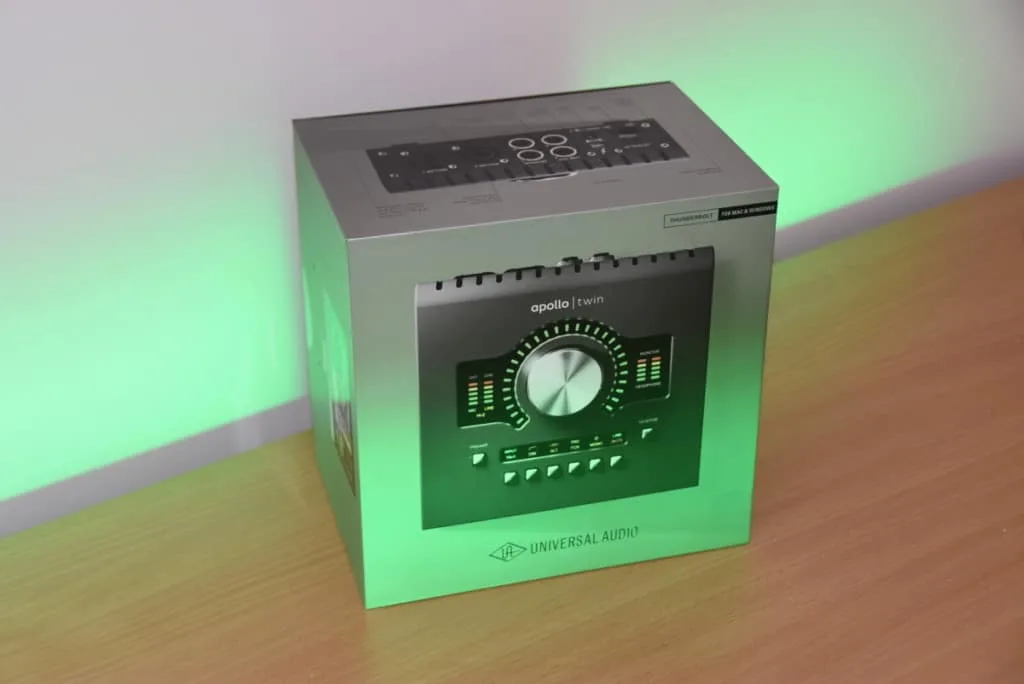
Getting Started: Drivers And A DAW
Most of these products are plug-and-play but in the quest of learning how to use an audio interface you have to know that depending on the system you are trying to use it with, you might be requested to install drivers.
These you can find at the manufacturer’s website. Once you have it installed you will realize it turns into your computer’s sound command. In case you are a Windows user, you can click on the little speaker icon at the taskbar in the bottom right corner and choose the audio interface as the main audio source.
No guide for new users would be complete without talking about the DAW.
The acronym stands for Digital Audio Workstation and there are plenty of paid and free options out there.
I have been using Pro Tools for over a decade now and am very happy with it. Some people choose Reaper, Ableton Live or Logic Pro; whichever is your choice, you’re going to have to watch a ton of tutorials and learn by trial and error.
- Don’t forget, Ableton software comes free with the Scarlett 2i2 audio interface
Think of designers learning to use Photoshop or audiovisual artists trying to use Vegas or architects learning CAD. The only thing you have to know about it is that it is indispensable to record music with your audio interface, so you HAVE to pick one.
Don’t Forget To Have Fun With Your Audio Interface!
Before going to the conclusion I just want to say that despite all the technical aspects I named above, recording music in your own home studio should be fun above all.
When I first started I almost broke up with the woman who is now my wife because I just lost track of time going into my very own bubble at my studio. Nowadays it is my way of feeding myself and my family and kids have broken that bubble into smaller versions.
Don’t forget to have fun, play around, learn, and make mistakes as well as amazing music.
Falling in love with the path and the process is the best way to ensure a bright musical future.
Final Thoughts
I hope that you are closer to understanding how to use an audio interface after reading this guide for new users. I avoided speaking about more complex things and focused on the heart and soul of your home studio which is the audio interface.
Happy recording!
